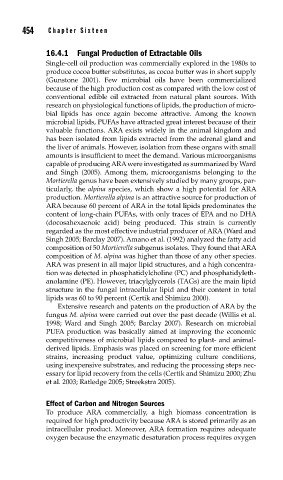Page 482 - Biosystems Engineering
P. 482
454 Cha pte r S i x tee n
16.4.1 Fungal Production of Extractable Oils
Single-cell oil production was commercially explored in the 1980s to
produce cocoa butter substitutes, as cocoa butter was in short supply
(Gunstone 2001). Few microbial oils have been commercialized
because of the high production cost as compared with the low cost of
conventional edible oil extracted from natural plant sources. With
research on physiological functions of lipids, the production of micro-
bial lipids has once again become attractive. Among the known
microbial lipids, PUFAs have attracted great interest because of their
valuable functions. ARA exists widely in the animal kingdom and
has been isolated from lipids extracted from the adrenal gland and
the liver of animals. However, isolation from these organs with small
amounts is insufficient to meet the demand. Various microorganisms
capable of producing ARA were investigated as summarized by Ward
and Singh (2005). Among them, microorganisms belonging to the
Mortierella genus have been extensively studied by many groups, par-
ticularly, the alpina species, which show a high potential for ARA
production. Mortierella alpina is an attractive source for production of
ARA because 60 percent of ARA in the total lipids predominates the
content of long-chain PUFAs, with only traces of EPA and no DHA
(docosahexaenoic acid) being produced. This strain is currently
regarded as the most effective industrial producer of ARA (Ward and
Singh 2005; Barclay 2007). Amano et al. (1992) analyzed the fatty acid
composition of 50 Mortierella subgenus isolates. They found that ARA
composition of M. alpina was higher than those of any other species.
ARA was present in all major lipid structures, and a high concentra-
tion was detected in phosphatidylcholine (PC) and phosphatidyleth-
anolamine (PE). However, triacylglycerols (TAGs) are the main lipid
structure in the fungal intracellular lipid and their content in total
lipids was 60 to 90 percent (Certik and Shimizu 2000).
Extensive research and patents on the production of ARA by the
fungus M. alpina were carried out over the past decade (Willis et al.
1998; Ward and Singh 2005; Barclay 2007). Research on microbial
PUFA production was basically aimed at improving the economic
competitiveness of microbial lipids compared to plant- and animal-
derived lipids. Emphasis was placed on screening for more efficient
strains, increasing product value, optimizing culture conditions,
using inexpensive substrates, and reducing the processing steps nec-
essary for lipid recovery from the cells (Certik and Shimizu 2000; Zhu
et al. 2003; Ratledge 2005; Streekstra 2005).
Effect of Carbon and Nitrogen Sources
To produce ARA commercially, a high biomass concentration is
required for high productivity because ARA is stored primarily as an
intracellular product. Moreover, ARA formation requires adequate
oxygen because the enzymatic desaturation process requires oxygen

